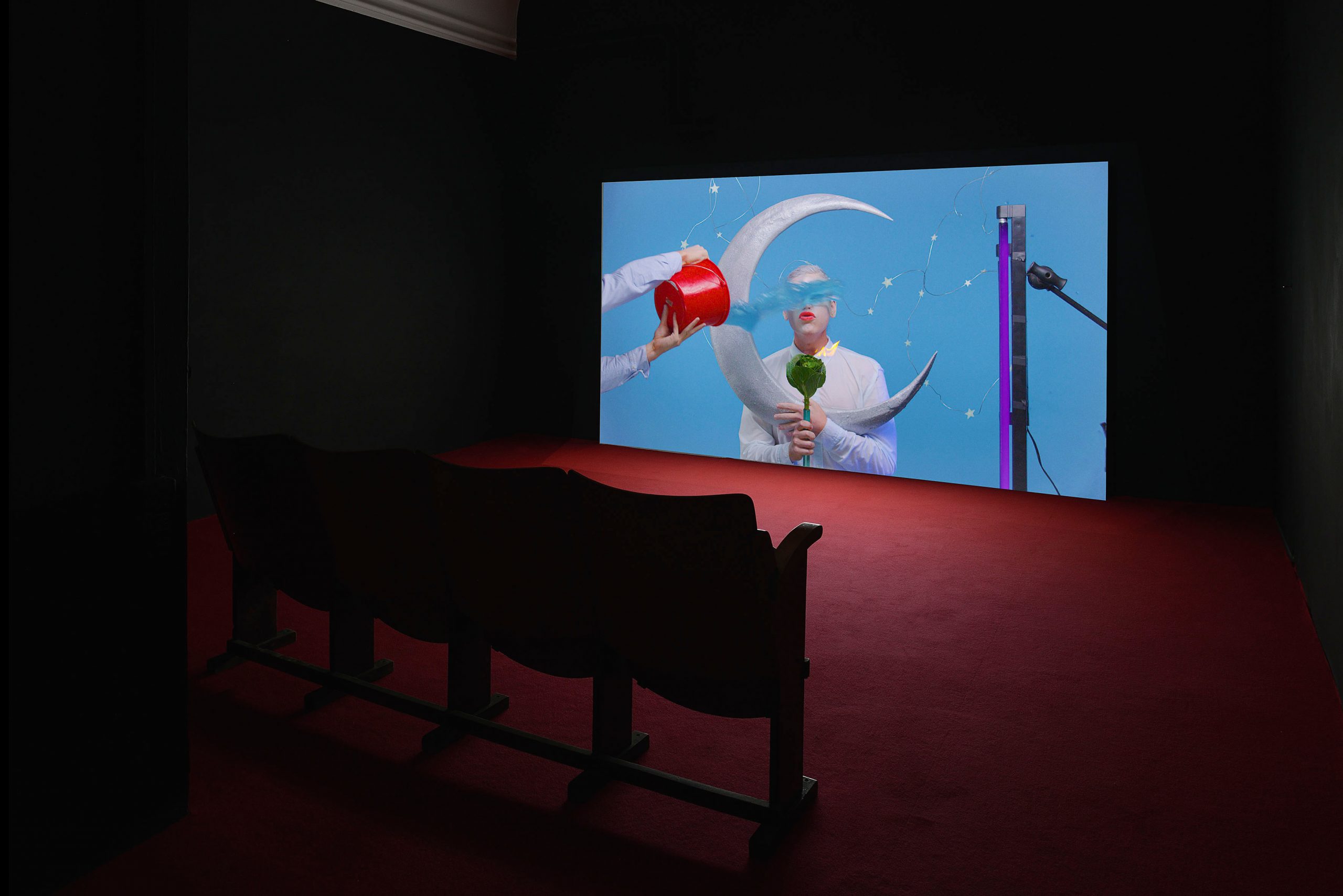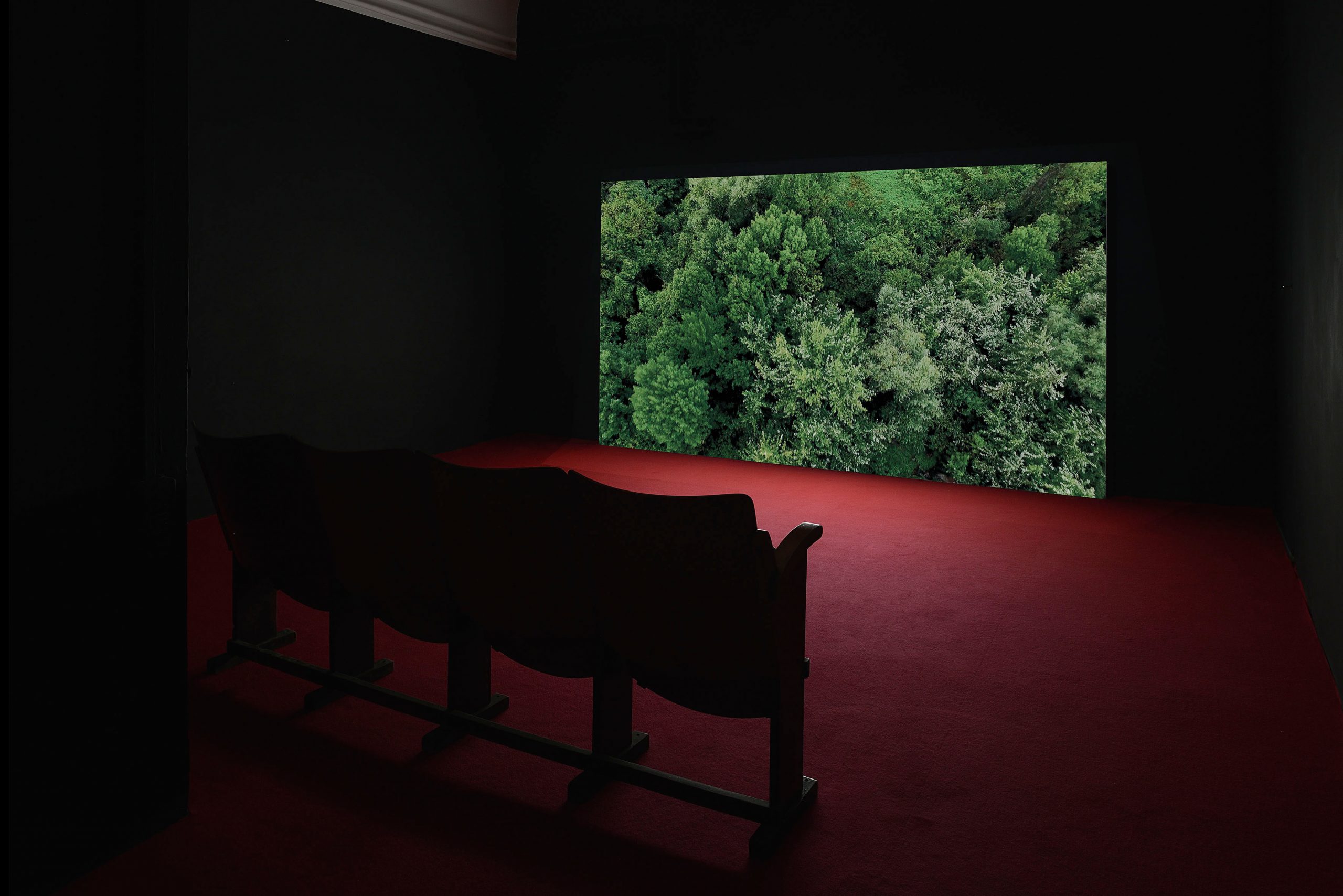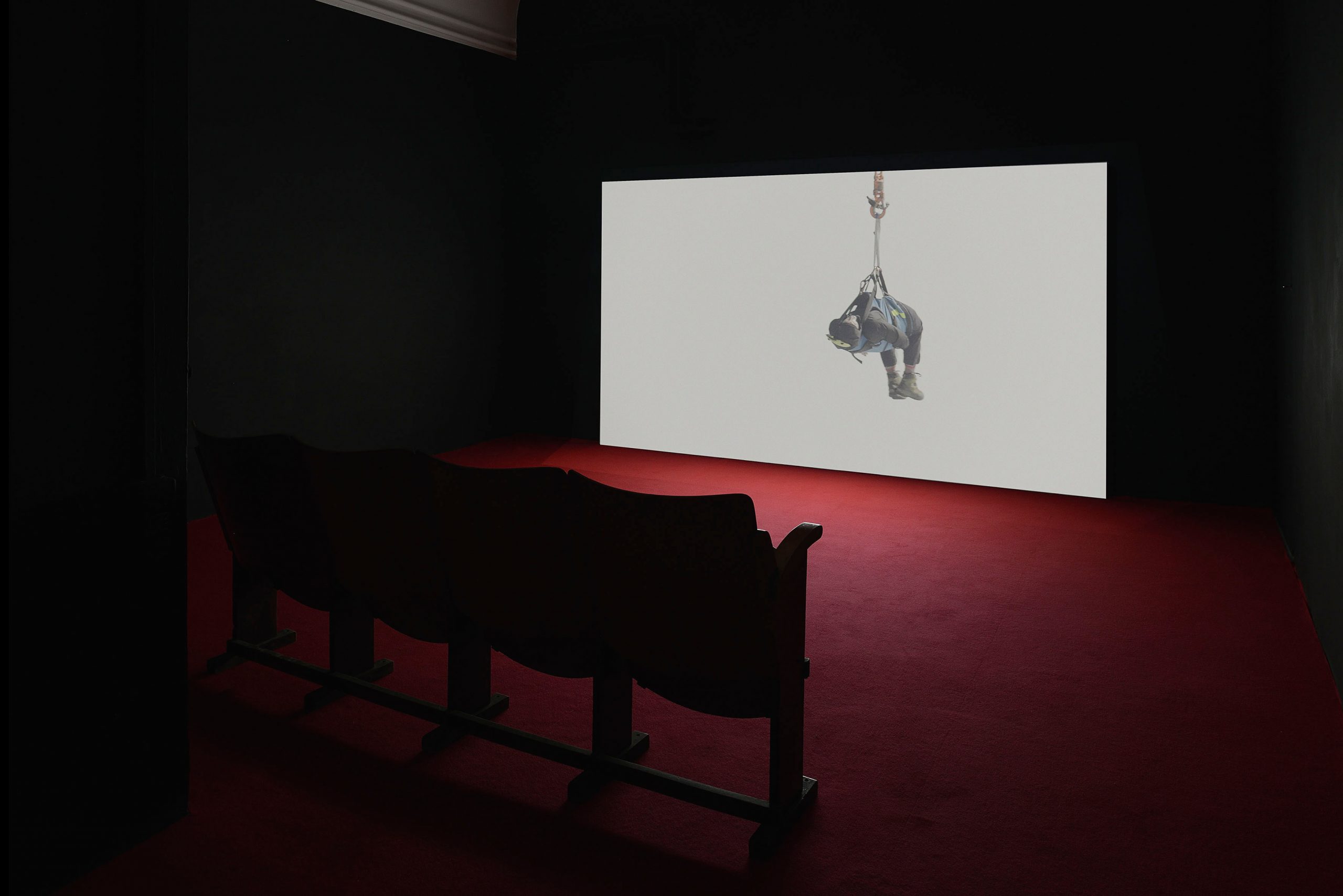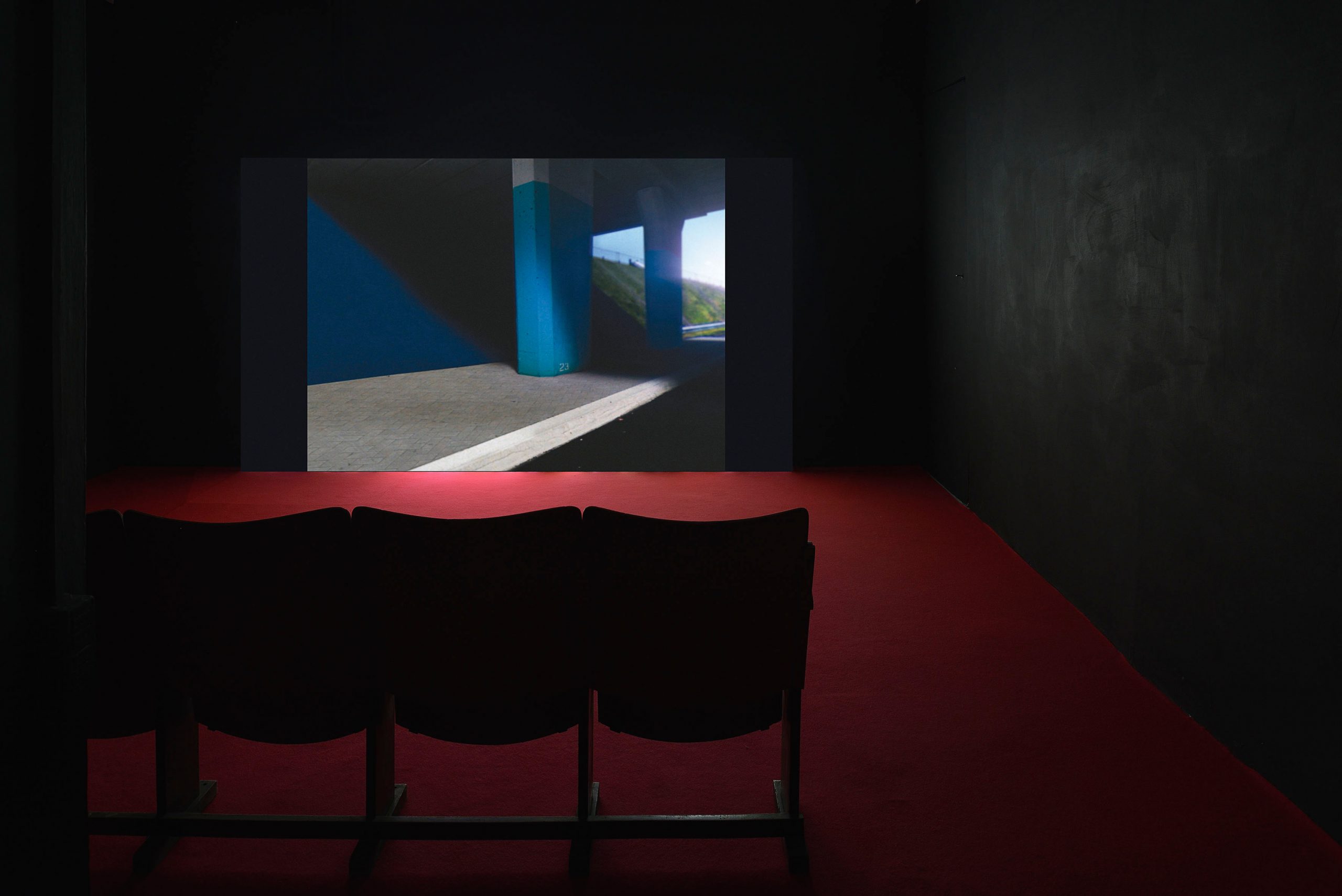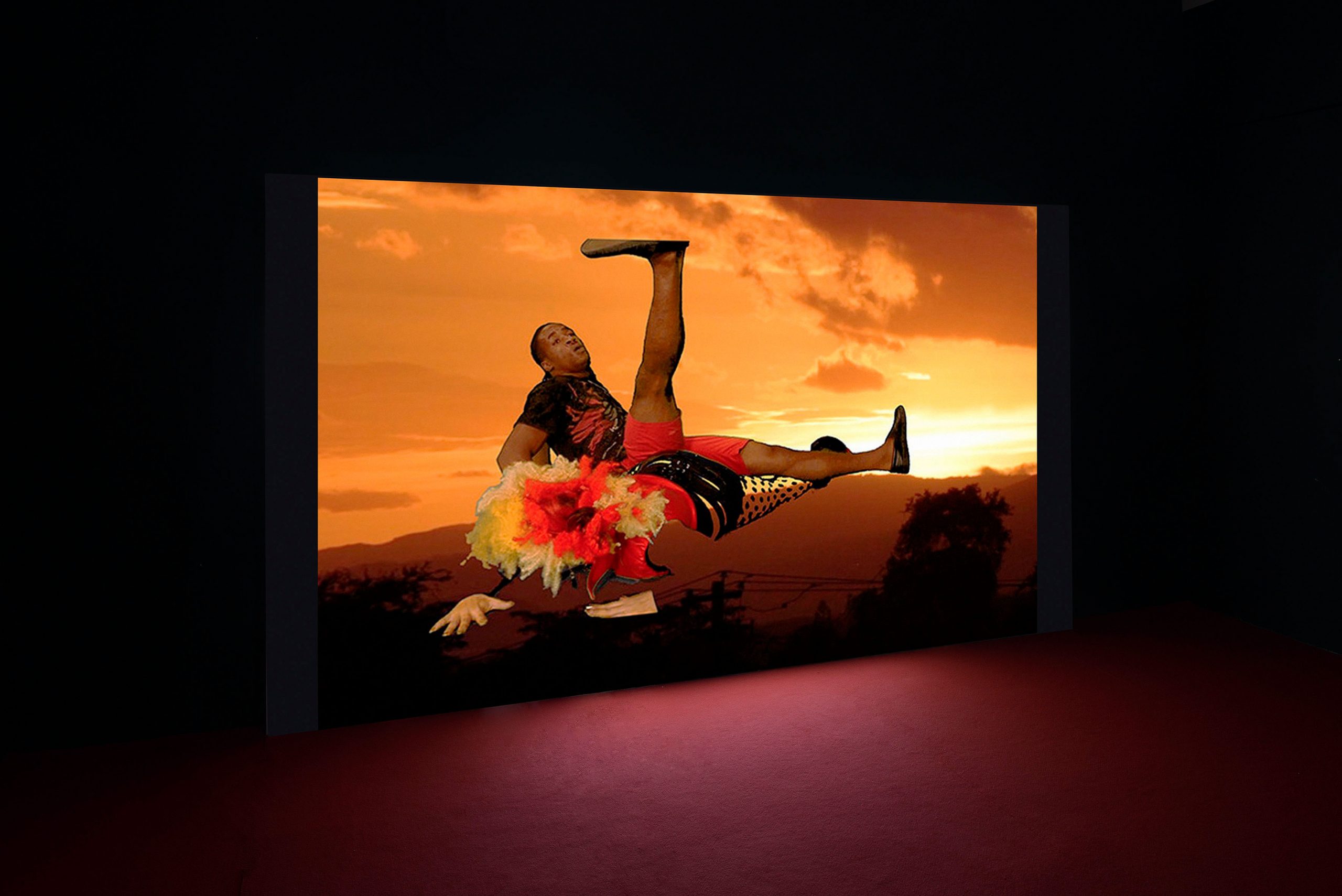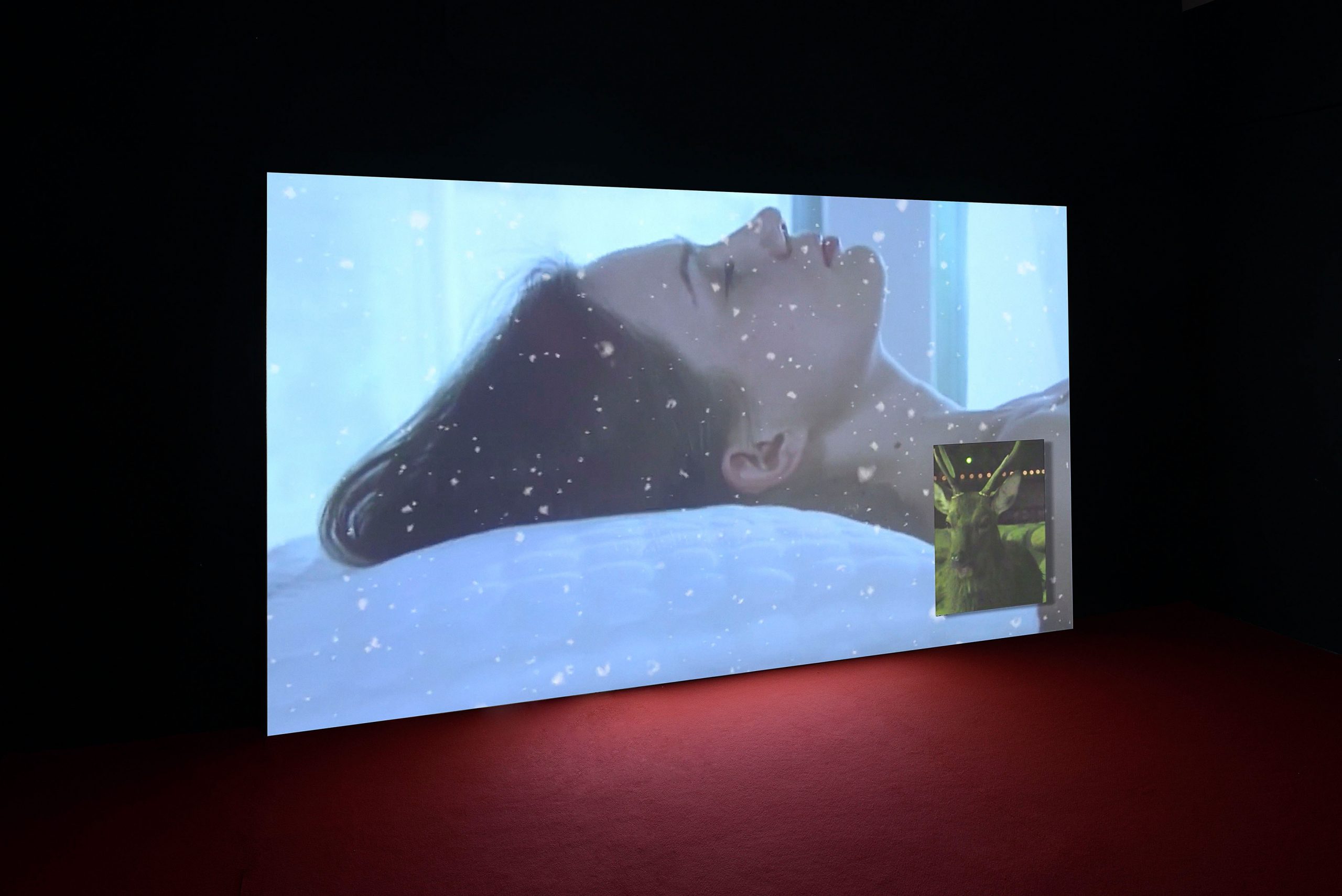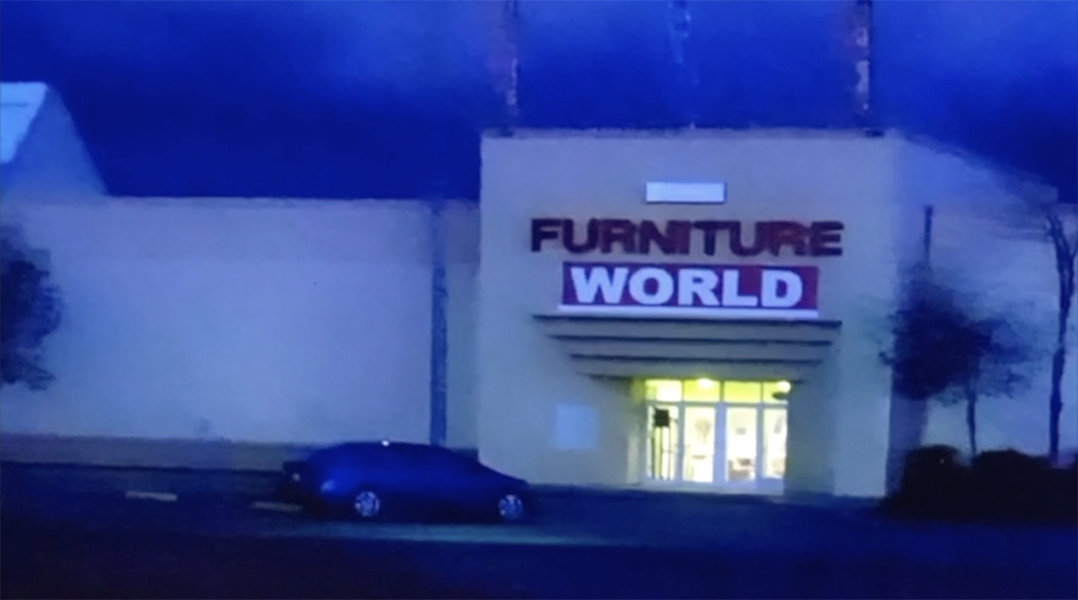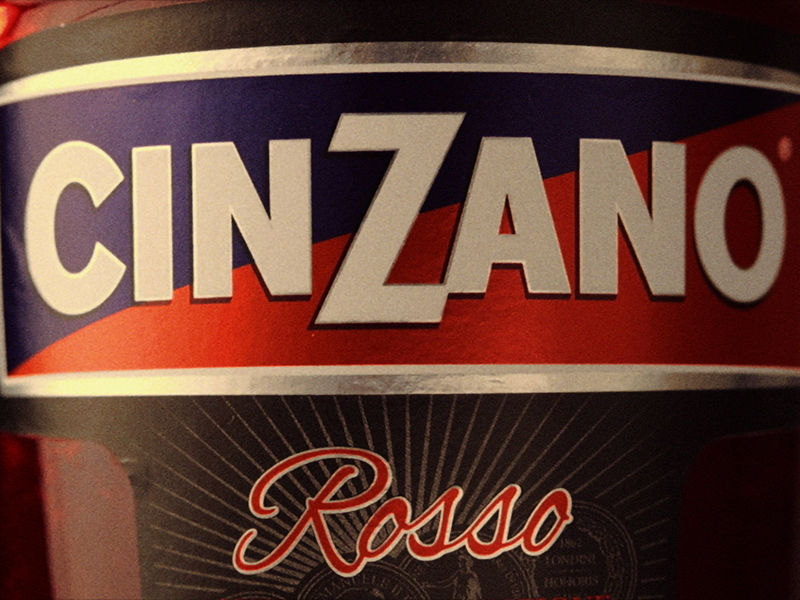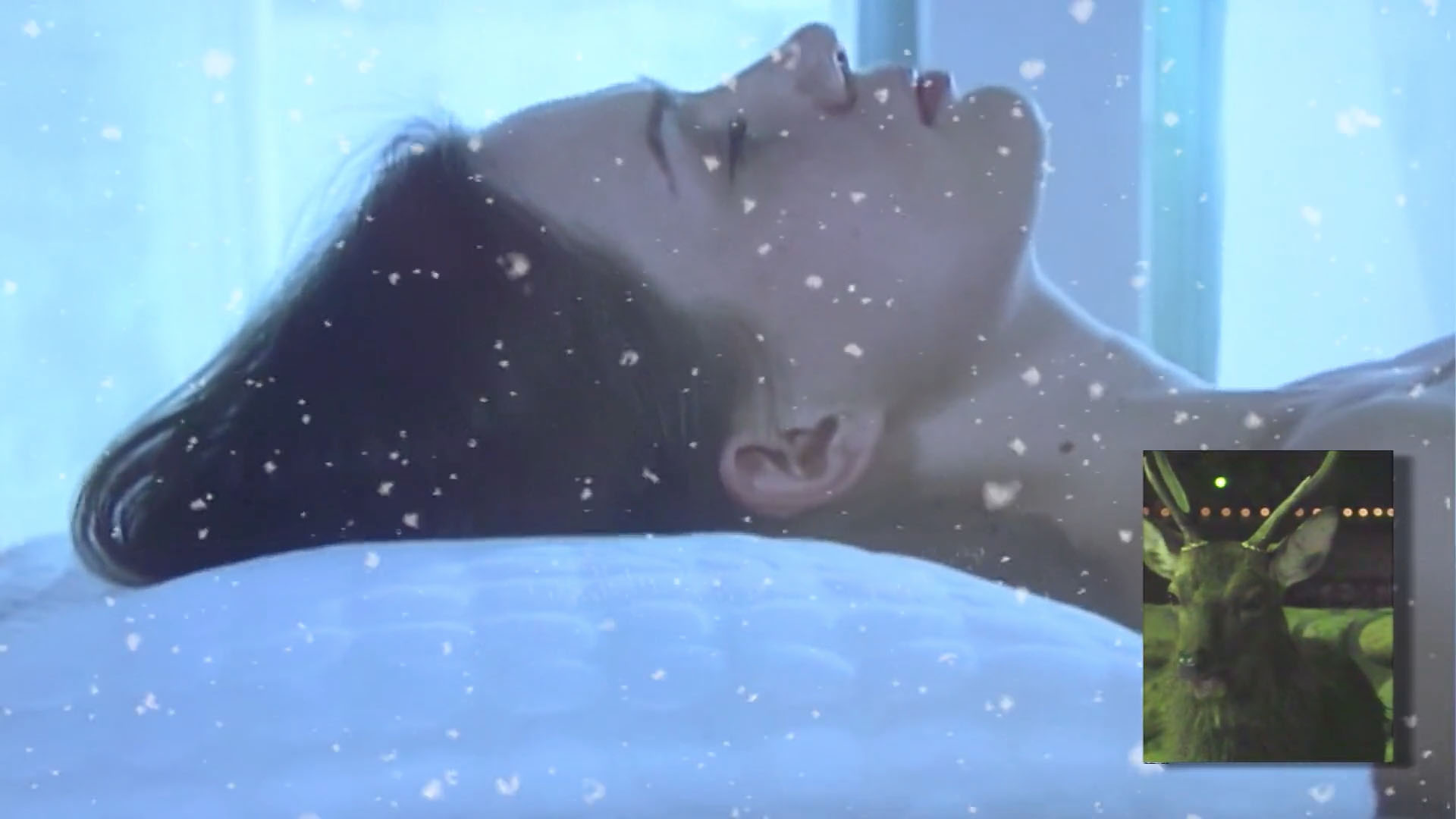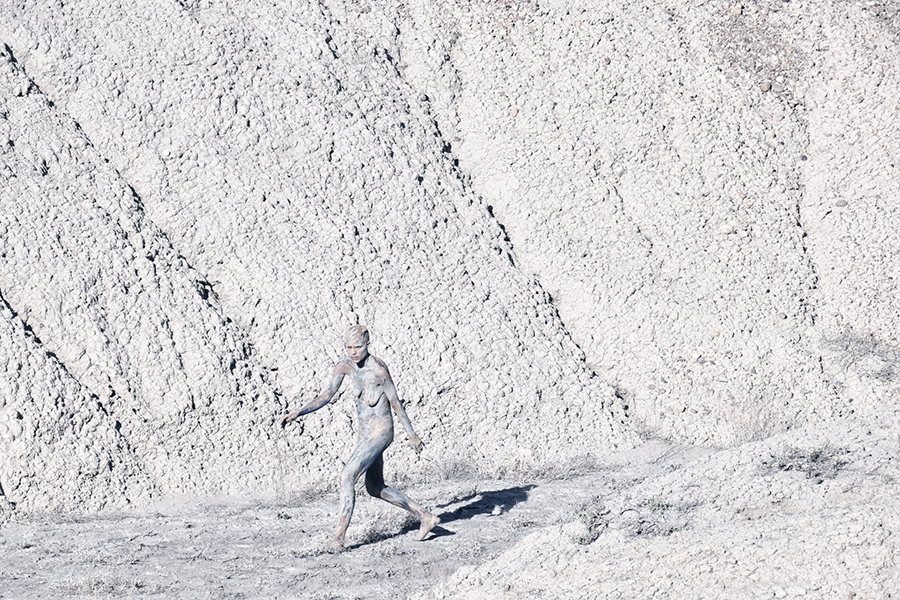Trisha Baga, Alex Da Corte, Jeremy Deller and Cecilia Bengolea, DIS, Cécile B. Evans, Mark Leckey, Anri Sala, Igor Simić, Colin Snapp with Mauro Hertig, Nico Vascellari
Film Program. The Dreamers: An Echoing
Basement Roma
January 25 — March 12, 2022
The Film Program, originally conceived for The Dreamers / 58th October Salon / Belgrade Biennale 2021, and slightly re-edited on this occasion, includes a selection of both historical works and new productions, most of which presented in Italy for the first time, pertaining to the personal sphere of the self-portrait and to the collective sphere of the historical tale, offering a meta-narration of moving images on the brink of a world in constant change, with its initiation rituals, illusions and disillusions, memory forgotten over time, and the urge of renewal.
January 25 — 28, 2022
Cécile B. Evans
A Screen Test for an Adaptation of Giselle, 2019
Cécile B. Evans’ work moves across installation, video, sculpture, and performance focusing on the value of emotion in contemporary society and its rebellion as it comes into contact with physical, ideological, and technological structures.
A Screen Test for an Adaptation of Giselle, presented in Italy for the first time, is an experimental screen test for an ongoing adaptation of the Industrial-era ballet Giselle as an eco-feminist thriller. The original tells the story of a fragile woman, betrayed to death, who rises in an afterlife propagated by a group of so-called scorned women. Now reimagined in a near-future, Giselle and her friends have moved from a failed metropolis to her mother’s rural village to ‘reset society’. An invasion of their successful community by an unnamed presence sets off a contamination of their newly formed ecosystem with old power dynamics. Here, Giselle’s death proposes mutability and multiplicity as a strategy for escape, with the force of natural “cultures” as an ally against the violence of essentialism. Weaving together high and low resolution, digital footage, 16mm, VHS recordings, animation, and deep AI, the screen test is a proposal for a hybridized world where multiple realities push to the surface.
Cécile B. Evans was born in 1983. Lives and work in London, UK.
January 31 — February 2, 2022
Igor Simić
Melancholic Drone, 2015
The artistic path of Igor Simić, initially only focusing on video, over time came to include a wide range of media, with the artist experimenting with photography, 3D-printed sculptures, music, writing of essays, articles, painting, as well as creating video games as part of the activity of his Demagog Studio transmedia company. The artist’s main line of research in the field of moving image goes together with his interest in contemporary culture and politics in a broad sense, and with an attention to the social dynamics of the dystopian technological era, involving surveillance systems and post-apocalyptic visions. From the illusions of advertising to the chimeras of the medicine of the future, from the fantasies of dating sites to the hypnotic language of algorithms, the world of today and tomorrow is probed by Simić with a gaze that is both direct and hallucinated, capable of highlighting unexpected perspectives and landscapes.
In the video Melancholic Drone (2015) a surveillance drone reflects on its own existence, flying over the city of Belgrade and following an unplanned trajectory. The drone, a humanized technological character, seems almost bored by its own functionality, a subtly ironic allusion to a theme that worries and fascinates the scientific community and certain movie productions: the possibility of a digital conscience.
Igor Simic was born in 1988. Lives and works in Belgrade, Serbia.
February 3 — 7, 2022
Nico Vascellari
Visita Interiora Terrae, 2020
Moving among various languages, including performance, sculpture, installation, drawing, collage, video and sound experimentation, Nico Vascellari pursues an artistic path that conveys different and contrasting forces and energies to disrupt the established order of things. His research is contaminated with the alternative underground scene, feeding on popular culture, folklore and an intense relationship with nature, to define a personal alphabet of gestures, signs, actions and images in constant growth and transformation, always balancing between individual perspective and collective experience. An almost shamanic, ritual dimension spreads from Vascellari’s projects and interventions, whether these come to life in genuinely artistic contexts or invade different spaces. The idea of layering, sedimentation and excavation is often the basis of the artist’s research, in an everlasting yearning for the exploration of deeper levels of the phenomena around us. A liminal thrust in terms of physical resistance, exposure to dangerous situations and loss of control, often expressed in the artist’s performances, is also present in the video Visita Interiora Terrae (2020), part of the Film Program. Vascellari evokes the poetic and scientific experiments carried out around the figure of the flying man, from Leonardo da Vinci onwards, with a reference to cinema in quoting the opening scene of Fellini’s La Dolce Vita (1960).
Nico Vascellari born in 1976. Lives and works in Rome, Italy.
February 8 — 11, 2022
Colin Snapp
Music by Mauro Hertig
Untitled, 2021
The photographs, videos and sculptural works of Colin Snapp investigate the mediated visual experience through which we perceive and catalog the world around us. Focusing in particular on the present American landscape, the artist reminds us that the way in which we look at and represent reality is never neutral, direct, and objective. Screens, frames, lenses, both figuratively and concretely, are the filter of apparitions that do not coincide with the essence of things but open up new perspectives on them. Snapp’s creative process starts from images considered ordinary or banal in order to then frame them and look for a new meaning. The act of photographing or filming becomes a conscious ritual of translating reality, a way of defining an unprecedented conceptual landscape. His voyeurism, far from any morbidity, takes on analytical and scientific characteristics.
Colin Snapp presents a new video featuring American shopping malls. The artist activates a thorough and detailed investigational process, undertaking weeks of research and filming, aiming to map these non-places where the mechanisms of consumerism seem to go ahead regardless of the ongoing economic and social crisis. The film’s soundtrack composed by Mauro Hertig starting from found sounds is a perfect commentary to the contradiction of images that move between the dullness of the ordinary and the disturbing universe of a recurring dream.
Colin Snapp was born in 1982. Lives and works in New York, NY and Los Angeles, CA, USA.
Mauro Hertig was born in 1989. Lives and works in New York, NY.
February 12 — 16, 2022
Jeremy Deller and Cecilia Bengolea
Bom Bom’s Dream, 2016
Jeremy Deller’s art production ranges from video to performance to installation. His work often takes on a political stance emphasized by the collaborative nature of many of his projects, where the value of single authorship is reduced in favor of a participatory dimension which often transcends the settings of art and conventional language codes. By questioning all forms of power (social, political, economic, religious), Deller’s research promotes the idea of freedom of expression, which he considers as a real engine for the definition of common values of coexistence. Cecilia Bengolea employs dance as a tool and a means for a performance-oriented research which constantly challenges the dimensions and codes of video, sculpture and installation. The artist conceives her choreographic production as a form of “animated sculpture,” which allows her to become both the subject and the object of the work. Dance is thus intended as a universal language that generates meaning, promoting an idea of community, of a possible future.
The video Bom Bom’s Dream (2016) by Deller and Bengolea documents a trip to Jamaica of the Japanese dancer Bom Bom, set between fantasy and reality, dream and wakefulness. Ritual and popular dimension, music and dance, natural landscape and dream universe, human, plant and animal realms all contribute to the outlining of a sort of initiatory path. The video opens with the figure of Bom Bom who, with her eyes closed, enters a dreamy scenery guided by the voiceover of a narrator-chameleon, diving into a marine scenario swarming with dancing animals. Moving from this immersive setting, the journey goes on through fantasy sections in which the dancer moves freely between earth and sky, whirling dizzily among the clouds, defying the laws of gravity and proportion, taking part in a dance-intercourse, to finally be literally swallowed up by her own dream. A sudden awakening then triggers clips from videos of the dance competitions in which Bom Bom takes part, amidst dust, noise and the swarming of bodies caught in hectic rhythmic movements.
Jeremy Deller was born in 1966. Lives and works in London, United Kingdom.
Cecilia Bengolea was born in 1979. Lives and works in Paris, France and Los Angeles, CA, USA.
February 17 — 21, 2022
Alex Da Corte
Blue Moon, 2017
A conceptual artist who works across a wide range of media, spanning video, performance, installation, painting and sculpture, Alex Da Corte mines high- and low-brow cultural references—from Surrealism and commercial product brands, to Pop Art and the icons and symbols from American life—to probe issues that include the politics surrounding culture and identity, alienation, and the psychological aspects of human experience. His works often take the form of a Gesamtkunstwerk, as immersive environments with vibrant chromatic and sensorial features that transform the dimensions of space and are capable of completely enveloping the viewer in a universe that is both alienating and familiar. Objects, symbols and images part of the common imagination become vehicles of additional senses, the touchstones of a language that goes beyond the ordinary.
The video Blue Moon (2017), presented in Italy for the first time and originally produced for the digital art exhibition Midnight Moment at Times Square, New York, portrays a surreal karaoke of the famous ballad by Richard Rodgers and Lorenz Hart, with an actor, dressed in white with bold stage make up and holding a silver crescent moon, crooning along to the classic. The scene, originally multiplied across several screens, located in unexpected places, evokes an almost oneiric theatricality, with the lyrics of the song flowing at the bottom of each screen, inviting the audience to take part in a simultaneously intimate and collective experience.
Alex Da Corte was born in 1980. Lives and works in Philadelphia.
February 22 — 25, 2022
Anri Sala
Dammi i Colori, 2003
Since the 1990s, Anri Sala has worked with a range of media including video, photography, installation, and more recently drawings and sculptures. His work explores the boundaries between image and sound in order to generate carefully assembled time-based moments which overlap one another. Through a new form of language, his work opens to multiple perspectives and interpretations, bringing together the past, present and future. Giving prominence to light, sound and space design, Sala’s work is often presented in immersive spaces, thus stimulating our senses and creating a link between the body and the architecture.
The film Dammi i Colori (2003) represents the changes the Albanian capital underwent following a program of urban renewal that involved the repainting in vivid colors of the city’s buildings. The voice of the then Mayor of Tirana Edi Rama—promoter of the project as well as an artist himself—describes this regeneration process, based on the ideas of hope and utopia. The video is a portrait of a changing city, full of contrasts, caught between night and day, with the sounds of everyday life on its streets. Interpreting the contrasts of reality from an intimate and daily perspective, the video has a profound political value. It offers a suspended observation of a changing and porous landscape and a deflagrated social fabric, but driven by the desire to rebuild itself.
Anri Sala was born in 1974. Lives and works in Berlin, Germany.
February 26 — March 3, 2022
Mark Leckey
Dream English Kid, 1964–1999 AD, 2015
Mark Leckey’s films, sculptures, installations, performances and sound works rework the objects and images of contemporary culture in a novel way, translating them into a language that is both individual and universal. Underground and clubbing culture, the world of youth and class issues, the intertwining of autobiography and history, memory and magic, identity and popular culture come together in a heterogeneous body of work, developed by the artist from the early ‘90s to the present, with a unique and original style. Leckey is one of the most iconic and representative artists of his generation and his works convey pressing issues of contemporary life in stories that are anchored in reality and in the physical and bodily experience that each individual makes of it.
Dream English Kid, 1964 – 1999 AD (2015) is a sort of mapping of Leckey’s cultural DNA, a “coming-of-age video” made out of a collage of found footage, music and sounds in which personal and collective memories, myth and reality, bodies and technologies, ghosts and dreams emerge in parallel. The result is an intense story, a sort of self-portrait made from anonymous materials (TV clips, YouTube videos, found objects and reconstructions of existing landscapes), in which mystery, folklore and technology converge to define a hybrid dimension somewhere between real and imagined world, between lived experience and dream.
Mark Leckey was born in 1964. Lives and works in London, UK.
March 5 — 8, 2022
Trisha Baga
The Voice, 2017
The work of Trisha Baga combines different media to explore themes such as gender identity, the mechanics of language and the relationship between the real and digital world. A preference for video and performance is accompanied by experiments in the production of sculpture or installation, and often ceramics as well as the collection of found objects. Her productions are characterized in general by a non-linear, open, permeable, intuitive quality. Materials and fragments from disparate aesthetic and semantic universes are freely incorporated, such as the imagery of television and cinema, and the language of the documentary or home video.
The 3D film The Voice (2017) is representative of the artist’s fluid and open compositional practice. It weaves together audio tracks from soundtracks of different musical genres and off-screen voices into a visual sequence of heterogeneous scenes: newspaper photographs; filming in the studio, during family trips or during simple daily activities; superimposed images; and subtitles. The work as a whole is articulated as a space in which the different elements that compose it open up to new possibilities of meaning. It is a field of free, spontaneous connections, similar to those of a dreamlike journey, where reality and fiction, memories and visions come together in a single magmatic fabric. The ordinary office chairs that accompany the installation and on which the visitor is invited to sit revisit the relationship between object and subject, acting as interferences or incursions between one dimension and another.
Trisha Baga was born in 1985. Lives and works in New York, USA.
March 9 — 12, 2022
DIS
Everything But The World, 2021
DIS is a collaborative project based in New York and consisting of Lauren Boyle, Solomon Chase, Marco Roso, David Toro, working together as an artistic and curatorial collective dealing with a wide range of media and platforms, exploiting the methods of production, use and dissemination of content online. Over time, DIS has enhances and amplified the possibilities and capabilities of art and its role in the artistic, commercial, educational, and public spheres—folding all into one.
Everything But The World—commissioned by the Centre d’Art Contemporain Genève on the occasion Biennale de l’Image en Mouvement (BIM) 2021 and premiered in Italy for this occasion—is a non-linear, natural history show about us — Homo sapiens. In a series of interrelated vignettes, Everything But The World links the agricultural revolution to Amazon fulfillment centers, addresses the gulf between the complexity of humans’ global existence and the smallness of their private, everyday lives, and confronts our obsession with “the end of the world”, knowing the arrogance of that word: ‘the’. Unlike most natural history shows, which seek to unify knowledge, name things, and craft an orderly though fragmented way of seeing, Everything But The World presents a strategy for changing history. To invent the history that will lead us out of this world.
DIS is a New York-based collective founded in 2010.


